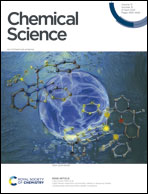Cucurbiturils mimicked by low polarizability solvents with pre-formed cavities: an empirical model to predict hydrocarbon selectivity†
Abstract
Relative binding affinities of a series of nine rigid hydrocarbons towards the cavity formed by a portion of the inner wall of cucurbit[8]uril (CB[8]) and a positive auxiliary guest were determined by competitive 19F NMR titrations in deuterium oxide. The corresponding free binding energies were corrected by the hydrocarbon computed solvation energies to obtain their free energies of transfer from the gas phase to the CB[8]/auxiliary guest cavity. These energies correlate linearly with the hydrocarbon static polarizabilities, thereby suggesting that the selectivity is driven, perhaps exclusively, by dispersive interactions between the hydrocarbons and the tailor-made cavity, regardless of the degree of unsaturation of the guests. The free energies of transfer also correlate linearly with the energy released upon introduction of the hydrocarbon into a pre-formed cavity extruded from a solvent (benzene) selected to mimic the polarity and polarizability of the CB[8]/auxiliary probe cavity – and this, with a unity slope. Among other features, this empirical model also accurately predicts the relative binding affinities of various rigid hydrocarbons to CB[6] and CB[7], as well as noble gases to CB[5], when the macrocycles are mimicked with pre-formed cavities in perfluorohexane or perfluorohexane/benzene mixtures, both being notoriously non-polar and non-polarizable environments.



 Please wait while we load your content...
Please wait while we load your content...